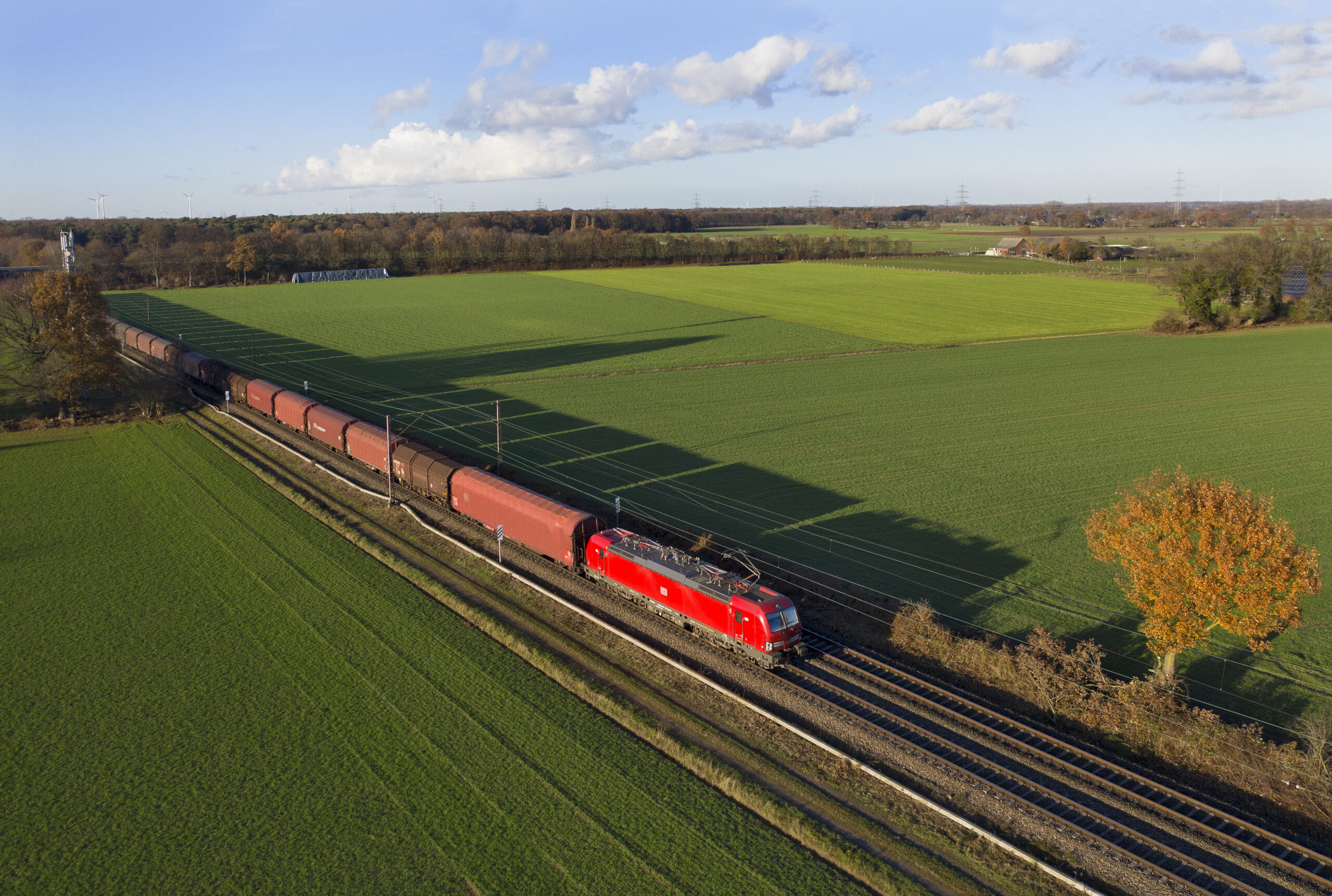
Net Zero Transformation
Shaping the Future of Sustainable Rail: Pioneering Net Zero Mobility
Railways have a natural energy efficiency advantage due to the steel wheel – steel rail interface leading to almost unmatched performance in terms of emissions per passenger or ton mile for the same power source. In addition, railways have a wider practical choice of power sources and energy delivery options compared to most other transportation modes, for example, zero emission wayside electrified railway systems have been in operation for over 140 years, nevertheless often the most flexible and economic option for railways has been to operate with diesel and utilizing the fuel efficiently. However, efficiency is no longer enough for railways to stay at the forefront of the global effort to combat climate change and move forward through sustainable development. Our clients, along with Deutsche Bahn’s own operations, are faced with increasing pressure to further reduce, and eventually eliminate, all emissions. Achieving such an ambitious goal in the challenging environment of railway operations requires well-defined goals and a clear vision of future operations.
DB E.C.O. North America brings together domestic and international experience in the development and implementation of net zero strategies at our Center for Net Zero Transformation in Rail and Transit (Center). The Center provides comprehensive support to rail and transit organizations throughout North America, guiding them through every phase of their journey towards achieving net zero mobility. Beginning with initial concept, strategy development and impact analysis, through pilots and technology demonstrations, and finally, planning and implementation of fleet transitions.
Our team considers all options of emissions reduction and elimination for motive power & rolling stock, stations, facilities, and supply chains from innovative technologies to procurement to operational procedures. We identify, and focus on, key levers feasible for each segment and client to reduce their lifecycle greenhouse gas emissions (GHGs) and criteria air pollutants (CAPs). This can include alternative propulsion methods, fuel type conversions, renewable power purchasing, sustainable procurement, and business processes, innovative fueling and maintenance practices, emission-free heating/cooling, and more; all areas where our team has deep technical expertise and hands-on experience.
Our Services
The Challenge
Rail and transit organizations are under increasing pressure, from internal and external stakeholders, to reduce or eliminate emissions from all sources within their organizations and throughout their supply chains. This includes scope 1, 2, and 3 GHG emissions in addition to CAPs. Although ZE technologies are maturing quickly in many light-duty sectors of the economy, the demanding operating environment of the railway sector makes implementation of those same technologies challenging. Our clients are facing a rapidly shifting landscape of technology options, with uncertain timelines for even those which are commercially available today.
The first step in establishing net zero operations is to develop a logical and realistic strategy, that defines the goals of the organization and provides a clear picture of the target future state. Such a strategy must be grounded in each organizations’ unique values, build upon a foundational understanding of technology options, and be supported by a realistic assessment of the impacts the transformation will have on the organization.
Our Service
Values Identification
The values held by an organization should provide the contextual frame within which all decisions are made. Building a net zero strategy based on those values will help to foster harmony between the organizations various goals and priorities, and supports buy-in from all stakeholders.
Clients who lack explicit sustainability targets, or that are embarking on the net zero path for the first time, will first need to identify how a transformation will impact each of their values. We help organizations with formalizing existing sustainability values, assist with their development, or support potential evolution in the context of net zero by providing strategic and technical subject matter expertise as well as industry insights from our work with domestic and international organizations.
Although this step may seem innocuous at first, it typically proves very difficult. For example, it’s common for our team to assist in answering the following types of questions:
- Safety is one of our primary values, how can we ensure alternative propulsion technologies won’t have a negative impact on this? Can we maintain or improve hazard mitigations?
- How soon can we expect to realize savings in operating expenses, and will this offset the capital outlays to ensure we remain good stewards of public funds?
- Customer service is at our organizations core, can alternative propulsion technologies improve the customer experience, and if yes, how do we quantify this?
- Should our organization be considering technologies that are still in development and have not reached commercial maturity?
- How should we define zero emissions? Does it include GHG and CAP or one of them? Which parts of the organization will zero emission apply to? Rail operations or infrastructure or both?
The answers to these questions can be completely different for any organization and finding the most suitable interpretation of values for each can be a very meaningful journey on its own.
Technology Understanding
To select a net zero strategy that is both ambitious and achievable, our clients need a foundational understanding of the technologies and concepts that can be implemented. Understanding the full landscape of zero emission technologies can be a daunting and academic task for anyone without prior expertise. At DB E.C.O. North America, we work with researchers and manufacturers across the globe that are at the leading edge of the field and can provide a fully tailored introduction that untangles the complex web of decisions. This can include pre-screening based on criteria established during the values identification stage such as:
- Environmental Impact – this can include looking at both low and zero emission at point of use options for rolling stock and infrastructure, as well as suitability for supporting net-zero targets that include scope 2 emissions (energy production) and scope 3 (supply chain emissions and impacts).
- Technical & Operational Suitability – this includes the performance aspects of the options and also items such as technology readiness levels (TRL) and commercial readiness levels (CRL).
- Economics – OpEx and CapEx modelling combined with funding availability and commercial availability.
- Synergies – unlike diesel, there is no guarantee an organization’s neighbors and peers will be using the same technology moving forward. Benefits of alternative power generation increase at scale, so combining demand with other users can help to reach optimal conditions.
DB E.C.O. North America’s presentation of this complex information in a clear and easy to comprehend manner provides even non-technical personnel with the opportunity to develop their understanding and knowledge to enable informed decision making.
Impact Assessment
The transformation from diesel-powered to zero emission rail vehicles and fully net-zero infrastructure can have a significant impact on the operations, and customer-facing services of a rail or transit organization. For many organizations, achieving parity between alternative propulsion systems and existing diesel-powered vehicles will require operational changes, which can include:
- New or modified maintenance facilities
- Modified stations
- Different fueling/charging schedules and locations
- Increased fleet size
- Modified equipment rotation plans
The alternative to operational changes is to revise service schedules to optimize the performance of the new propulsion systems. Either option will have an impact on the organization and estimating the extent is a critical component to consider when identifying the net zero strategy and transition of an organization.
Our Experience
DB E.C.O. North America has been integral in the development of some of the most ambitious net zero rail strategies in North America. Our experience with domestic clients is complemented with the in-house work at Deutsche Bahn in Europe as well as international clients of DB E.C.O. Group in markets such as South America and Australia.
The Challenge
The transformation of rail and transit organizations from diesel-powered to alternative, zero emission propulsion and infrastructure technologies is a massive undertaking. Implementation can extend beyond vehicle procurements and require infrastructure retrofit or construction, service and operational changes, employee training, public and ridership outreach, changes to power purchasing strategies, and educational campaigns. Identification of the main emission contributors within each of the scopes, and associated primary reduction levers, requires detailed analysis and significant technical knowledge. For most organizations this will require skills and expertise not currently available in-house, and which are impractical to acquire on a long-term basis through full-time staffing.
Our Service
Define Strategic Cornerstones
DB E.C.O. North America analyzes fleet and infrastructure strategies, along with planned and ongoing procurements to determine alignment with net zero strategy goals. This includes identifying and defining the appropriate strategic cornerstones of each organization’s unique journey to net zero.
The six most common cornerstones that we have developed for clients to reduce or eliminate emissions from rail operations are as follows:
- Technology selection and implementation pathways
- Funding strategy
- Technology and vehicle pilots
- Infrastructure development
- Procurement strategy
Technology Selection & Implementation Pathway
Selection of final technology solutions for motive power and infrastructure requires high-level feasibility analysis. For motive power options, this requires detailed duty cycle simulations with iterative optimization of vehicle performance and energy storage. DB E.C.O. North America performs this work using our proprietary, in-house, rail simulation tools. These tools have been validated against real-world operations and OEM provided vehicle data, to ensure accurate results that our clients can rely on throughout procurement and planning. Determining feasibility of options for infrastructure and stationary assets is based on detailed emissions modelling. DB E.C.O. North America has extensive experience with tools such as the Greenhouse Gases, Regulated Emissions, and Energy Use in Transportation Model (GREET). Our team provides the technical expertise to configure these tools to each client’s needs, and then correctly interpret and apply the results to identify optimal technology packages.
Technology selection is followed by detailed cost-benefit analysis of the implementation pathway for each vehicle and infrastructure type. The detail and accuracy of the simulations and modelling allows the DB team to make data-driven recommendations on the optimal pathway(s) for each client and is supported by our hands-on experience implementing all options.
Funding Strategy
Although passenger rail organizations in North America have extensive experience with program funding to support operations, most have limited exposure to funding requests on capital projects, and freight rail organizations have minimal experience with either. This can be a daunting process to ensure proper matching dollars are available and then preparing complex cost-benefit analysis (CBA) models. The DB team has supported many such clients to develop funding strategies, starting with identifying opportunities, vetting matching options, prioritizing applications, building CBA models, and coordinating collaboration with other potential bidders.
Technology & Vehicle Pilots
DB E.C.O. North America supports all aspects of pilot vehicle operations, starting with specification development, through R&D and manufacturing processes, into testing and commissioning, and finally performance validation and employee training. This includes design and specification of all supporting infrastructure (maintenance, fueling or charging, safety, etc.) either for temporary or permanent use. Our team has extensive experience in this area and is currently involved with two North American projects: Hydrail Goat Project (Vancouver, BC) and SBCTA ZEMU Project (San Bernardino, CA).
Technology pilots on the infrastructure side of the operation require similar steps to vehicles, though typically less focus on R&D and shorter overall implementation timelines. Deutsche Bahn in Germany has been leading the way in this area of sustainability since 2014, when the first “StationGreen” opened in Kerpen-Horrem, Germany. This climate-neutral station obtains it’s entire energy demand for heating and lighting by means of green energy from a combination of geothermal heat and solar panels. The station design also employs sophisticated design elements and a balanced lighting concept.
The DB E.C.O. North America team leverages this corporate experience with the latest research and innovations to advise and assist clients with all aspects of pilot operations.
Infrastructure Development
Following successful pilots the DB E.C.O. North America team can walk clients through the entire infrastructure development and implementation phases. For example, optimal fueling and charging infrastructure placement and sizing is supported by the detailed simulations performed in earlier stages, allowing the DB team to reduce or eliminate changes to existing service plans or to optimize new plans based on updated vehicle performance characteristics.
Detailed cost-benefit analysis of pilot operations is completed, and results are fed into models of the entire network. This allows the DB team to optimize any trade-offs between infrastructure capital expenses (location, quantity, technology package, etc) and service changes or operating expenses. Matching planning work to funding strategies is also a critical component of this step.
Procurement Strategy
Once again, the simulation results created in the early stages provide the necessary data to derive detailed technical/performance specifications for pilot and final vehicle and technology procurements. Additionally, our team provides support throughout negotiations with original equipment manufacturers (OEMs) and can work with their teams to cross-validate simulations. This ensures that the vehicles and technology being purchased are not only fit-for-purpose in terms of technical performance, but also optimized for both capital costs and operating costs.
The DB team has world-leading experience in all aspects of the procurement process, including technical design reviews, component inspections, sub-system design validation, quality assurance, and vehicle test supervision. This is another area where DB employs sophisticated tools and models, such as Argonne’s Heavy-Duty Refueling Scenario Analysis Model (HDRSAM), to validate cost proposals. Our team has experience configuring these complex tools to ensure outputs meet the unique needs of each client and provide procurement teams with the knowledge necessary to complete accurate and robust analysis of all options.
Our Experience
We are global leaders of the development and implementation of the entire ecosystem for alternative motive power systems and sustainable infrastructure for railway operations, including collaborations with manufacturers on Deutsche Bahn’s own vehicles and infrastructure. The in-house, real-world expertise of DB E.C.O. North America is further developed through our work with clients like San Bernardino Country Transit Authority (SBCTA) in California, helping to acquire the commercial, FRA compliant, hydrogen fuel cell multiple unit for the U.S. market and Vale in Brazil, implementing battery-electric locomotives in their mining operations.
Contact
Andreas Hoffrichter

Chris Beringer



